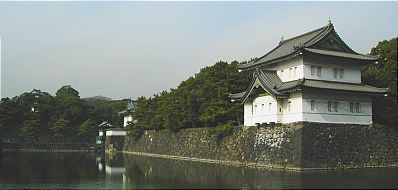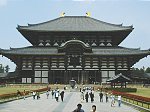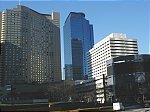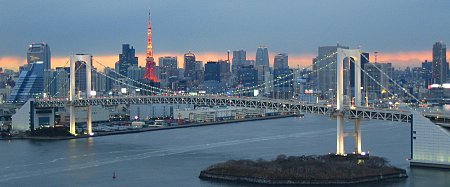
CENTRAL TOKYO highlighting my favorite places:

KANEIJI TEMPLE IN UENO

Shinjuku (Tokyo) - This is the craziest, busiest, seemingly most populated, most high-tech areas that exist on the earth. It makes activity in NYC Mid- & Down Town, Rio's Copacabana, and Central Hong Kong look second or third tier compared to the crazy, incomprehensible activity of Shinjuku - my favorite area of Tokyo. Traditional Central Tokyo (Ginza& Central Castle Park Area) are wild, but Shinjuku is undescribable.
What other city has a huge skyscraper for its Operaand other performing arts? Where can you enter City Hall (in 2 or 3 huge buildings in Central Shinjuku) and end up eating a free lunch, as a guest in the luxurious middle management DINING ROOM of CITY HALL, while as Brazilians (I was with one), I was given sophisticated instructions for Earthquake and Evironment Protecetion in Brazilian Portuguese!
 Shinjuku by night.
Shinjuku by night.
Our Neighborhood in Tokyo - IKEBUKURO


The Ikebukuro Business District where our Hotel - the Crowne Plaza is located.
Tokyo is Japan's capital, the country's largest city, Asia's dominant metropolis, and far and away the world's largest city and metropolitan area. Tokyo is one of Japan's 47 prefectures, but is called a metropolis (to) rather than a prefecture (ken). The metropolis of Tokyo consists of 23 city wards (ku), 26 cities, 5 towns and 8 villages, including the Izu and Ogasawara Islands, several small Pacific Islands in the south of Japan's main island Honshu.
The 23 city wards (ku) are the center of Tokyo and make up about one third of the metropolis' area, while housing roughly eight of Tokyo proper's approximately 12 million residents. The metro area is well seen from towers in Shinjuku and Ikebukuro. In fact from Ikebukero one evening, I saw all the Tokyo Disneyland fireworks, as well as the air traffic from Tokyo's Narita (international) and Haneda (domestic & one of the world's busiest) Airports, as well as the intensive helicopter service, and the shipping along the river and in Yokohama.
This is home to over 32 million in the Tokyo metropolitan area, covered by an intensive and extensive subway and train system, integrated with the huge malls and leading department stores, even designer boutiquers, enabling you to buy Godiva Chocolates and a cartier Watch at one stop, and dine at a Maxim's, then buy jewelry at a Tiffany's, and a suit at Armani's before going home. And the queues (lines) are endless.

If you don't look Japanese, nobody will serve you. They'll know you're cheap, won't know what you really want or want to know the price first, not know the the language, and will take up as much time as 10 or 12 Japanese customers. So, your business is not wanted in these places. Don't worry, you'll know when they don't want you. After seeing bowing females give brochures and discount pamphlets to dozens of people, suddenly you (a blond and a South European type) are skipped over, and ignored as plague infectors.
So don't go in a line bunless you speak Japanese. Most essential items are machine-purchasable, with the animated bowing-Japanese-woman-in-kimono to thank you. Next, get out of line. They're busy. Many are waiting. Hurry!
Prior to 1868, Tokyo was known as Edo. A small castle town in the 16th century, Edo became Japan's political center in 1603 when Tokugawa Ieyasu established his feudal government there. A few decades later, Edo had grown into one of the world's most populous cities.
With the Meiji Restoration of 1868, the emperor and capital were moved from Kyoto to Edo, which was renamed Tokyo ("Eastern Capital").
Large parts of Tokyo were destroyed in the Great Kanto Earthquake of 1923 and in the air raids of 1945. But like a zenith, Tokyo came back, and became, arguably, the planet's largest, most populous, and wealthiest city.

Nenhum comentário:
Postar um comentário